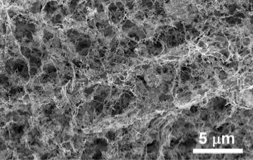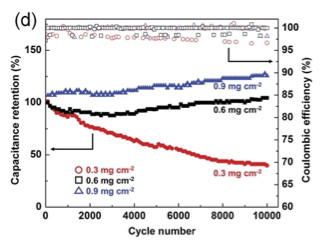Scalable, Binerless And Carbonless Hierarchical Ni Nanodendrite Foam Decorated For Supercapacitors
Patent Status
| Country | Type | Number | Dated | Case |
| United States Of America | Issued Patent | 11,056,288 | 07/06/2021 | 2016-351 |
Full Description
Background
Supercapacitors with higher power density and higher energy density will play an important role in applications that depend on intermittent energy sources (such as wind) and in regenerative recharging in automobiles. Pseudo-capacitors take advantage of fast and reversible surface redox reactions to provide 10-100 times higher energy density than electric double layer capacitors. Among metal oxides used for pseudo-capacitors, Ruthenium Dioxide (RuO2) – especially the hydrous and amorphous RuO2 exhibits superior performance – though scarcity and high price prevent its large-scale production.
Current Invention
Inventors led by Profs. Cengiz and Mihrimah Ozkan have developed a patented, Nickel (Ni) Nanodendrite attached on Ni nanowire backbone which is synthesized directly on Ni foam as a novel support for hydrous RuO2 nanoparticles and its application to symmetric supercapacitors. In their synthesis, hydrous RuO2 nanoparticles are dip-coated onto Nickel Nanodendrite Foam (NDF) and annealed at 150 deg. C under vacuum.

Scanning electron microscopy image of RuO2 coated NDF.

Capacitance retention and coulombic efficiency at various RuO2 loading.
Advantages
The novel aspects of their innovation are:
State Of Development
Lab level prototype.
The team fabricated lab level prototypes for performance characterization. Operated at 1.6V the supercapacitors displayed impressive specific capacitance of 678.57 Farads/gram with a high energy density of 60.32 WH/kg. Even at large current density of 100 A/gram, the prototype maintained a high energy density at 19.73 Wh/kg and a high power density of 40 kW/kg. Coulombic efficiencies were greater than 99.5% even after 10,000 cycles.
Suggested uses
- Super- and Ultra-capacitors
- Rechargeable energy storage
- Applications that depend on intermittent renewable energy source such as wind.
- Regenerative recharge during braking for automotive applications.
Related Materials
Contact
- Venkata S. Krishnamurty
- venkata.krishnamurty@ucr.edu
- tel: View Phone Number.
Other Information
Keywords
Ruthenium Oxide, Nickel nanodendrite foam, Supercapacitor, Ultracapacitor, Regenerative recharge, Electric vehicle, Intermittent power source, Energy storage, Electrochemical energy storage
